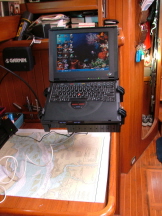
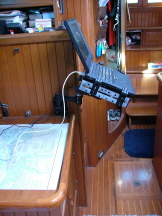
PROJECTS
PREPPING FOR BLUEWATER
What might one do to get a twenty-year-old veteran cruising boat updated and eady to rock-and-roll again after ten years of the easy life. Here's a sample of projects we've recently completed. Unless stated otherwise, we did all of the work ourselves.


Added a swing-arm mount for the IBM laptop computer. When we need to get a chart out from under the table, the computer swings out into the aisle, allowing the hinged table top to open. This turns out to be a convenient position for using the PC while standing--may come in handy at sea. This is our old computer. We use it primarily as a radio and navigation interface. With it we can send email and receive weather faxes via our single-sideband radio while at sea. Our new laptop, used for internet access, website management, photo management, word processing, etc. is an HP Pavilion ZE 560. It sits wherever we put it. We have a Pelican case to take it on wet dinghy rides ashore to Internet cafes. In the left-hand photo you can also just see the new Garmin GPS that will provide us a continuous fix of our position.
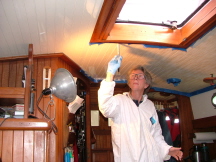
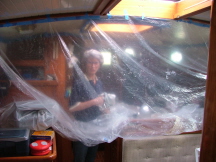
One of the big projects was repainting the cabin overhead (ceiling) from bow to stern. Kay did virtually all the work. It was harder than it looks because the Interlux Brightside polyurethane enamel dries so fast that it is difficult to keep a wet edge to avoid lap marks. To do this she had to paint only 2 to 4 battens (the individual strips) at a time. It's all done now and looks great.
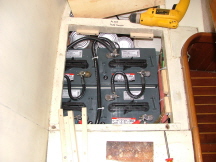
A significant project for Steve was adding an additional bank of batteries. An AC hotwater heater used to reside in this location. When it failed for the second time we decided we didn't need it because we could also make hot water with our diesel heater and/or our diesel engine. With the addition of larger solar panels and a new wind turbine generator, it seemed like a good idea to use the space to increase the size of the reservoir for the electrical power we are now capable of generating. The four 6-volt batteries seen here add 430 amps of 12-volt power to our existing bank of 630 amps.
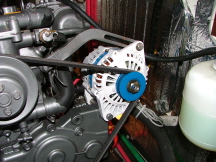
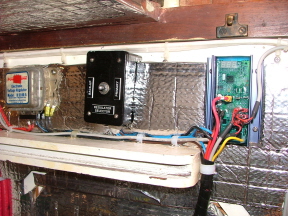 The solar panels and wind turbine may
not always provide for all of our electrical needs. Naturally,
our new Yanmar diesel engine came with an alternator for charging
the batteries. Another project was to replace the stock
alternator with a higher output alternator and a
"smart" regulator that would maximize charging
efficiency. In these two shots you see the new Balmar 110 amp
alternator and the Balmar Max Charge regulator (the blue gadget
in right photo). The black box to the left of the Max Charge is a
switch box that allows us to instantly switch control of
regulation to a back-up regulator (the silver box to the left of
the switch). We had this set-up on our last cruise and it paid
off when the regulator we had then packed it in. Even this new,
higher output alternator would not be sufficient to charge our
rather large battery system. We are counting on the sun and the
wind to do must of the work, with the alternator/engine filling
in as necessary. We'll let you know how it goes. Here at the dock
in Gig Harbor, we haven't had the battery charger on for over a
month, while all the time using the fridge, lights, water pump,
etc. But we'll be using a lot more juice underway and at anchor.
The solar panels and wind turbine may
not always provide for all of our electrical needs. Naturally,
our new Yanmar diesel engine came with an alternator for charging
the batteries. Another project was to replace the stock
alternator with a higher output alternator and a
"smart" regulator that would maximize charging
efficiency. In these two shots you see the new Balmar 110 amp
alternator and the Balmar Max Charge regulator (the blue gadget
in right photo). The black box to the left of the Max Charge is a
switch box that allows us to instantly switch control of
regulation to a back-up regulator (the silver box to the left of
the switch). We had this set-up on our last cruise and it paid
off when the regulator we had then packed it in. Even this new,
higher output alternator would not be sufficient to charge our
rather large battery system. We are counting on the sun and the
wind to do must of the work, with the alternator/engine filling
in as necessary. We'll let you know how it goes. Here at the dock
in Gig Harbor, we haven't had the battery charger on for over a
month, while all the time using the fridge, lights, water pump,
etc. But we'll be using a lot more juice underway and at anchor.

Speaking of the wind turbine, here it is. It's called an Air-X Marine and is capable of putting out 30 amps in ideal conditions (very windy but not too windy). Steve constructed the tower himself rather than buy one made up. This allowed us to do it in stainless instead of powder coated aluminum. We made the tower do triple duty. Aside from being the support for the turbine, it also serves as our new flag staff, and it provided a convenient place to attach a Garhauer outboard davit for lifting the outboard off the dinghy or lowering it down. This was a real chore for us without a davit. In many anchorages in the South Pacific we would have 2-foot wind chop. Lowering or handing up the outboard from a pitching dinghy was like trying to do it while standing on the back of a bucking horse. The davit has already paid off in an unexpected way. When it was time to re-mount our Monitor steering vane (not shown), we didn't have to turn the boat around in the slip to bolt the vane on the stern. We just put the Monitor in the dinghy and hauled it up with the davit--ten times easier than even doing it from the dock.
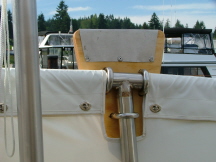
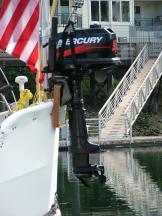
To mount the outboard on the stern we needed a mount. All of the ready-made mounts are set up for 1" rails. We have 1-1/2" rails on our bow and stern pulpits. So, Steve had to make the mount you see in the left hand picture, using plywood, epoxy and sheet stainless steel.
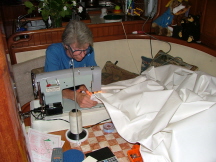
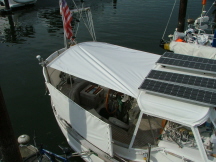 In the above photos you saw what are
called weather cloths surrounding the cockpit. These were one of
three canvas and upholtery projects that we contracted out. We
also had a new dodger cover built (the windshield) and new
interior cushions. In addtion to these projects, Kay made us a
new cockpit awning similar to the one she made for our last
cruise. However, the new one has a new feature. She also made
"wing panels" that connect the awning to the weather
cloths, filling the gap you see in the photo immediately to the
left. You also see the four 55-watt solar panels on top of the
new dodger.
In the above photos you saw what are
called weather cloths surrounding the cockpit. These were one of
three canvas and upholtery projects that we contracted out. We
also had a new dodger cover built (the windshield) and new
interior cushions. In addtion to these projects, Kay made us a
new cockpit awning similar to the one she made for our last
cruise. However, the new one has a new feature. She also made
"wing panels" that connect the awning to the weather
cloths, filling the gap you see in the photo immediately to the
left. You also see the four 55-watt solar panels on top of the
new dodger.

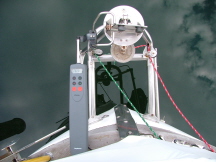 In addition to the new GPS, there were
two more significant electronic upgrades. On the left is an
Interphase Dual Scan Color Sonar. This device lets us
"see" underwater and is analagous to our radar. The
radar shows us what's on or just above the surface of the water,
while the new sonar will show us what's at or below the
surface. We're hoping it will be useful primarily for coral
navigation; i.e., navigating through passes in coral reefs and
across lagoons with coral heads lurking about. Secondarily, when
making ocean passages we hope it will warn us, via its alarms, of
logs, shipping containers, sleeping whales, and anything else
that might be in our path. The gray device in the right-hand
photo is a "tiller-pilot" seen looking down over the
stern. It would normally be used as an autopilot for a
tiller-steered boat, but in this case Steve has interfaced it to
our trusty old Monitor steering vane. The steering vane normally
has a large white paddle sticking up in the air. When the paddle
is deflected by a change in wind direction it causes a chain
reaction resulting in the rudder being turned to alter course
relative to the wind. That works fine as along as there is enough
apparent wind, and as long as you don't need to steer a really
fine course. By interfacing a relatively inexpensive tiller-pilot
to the Monitor we gain some significant advantages: we can steer
a razor sharp course, with almost negligible power consumption
(tilting the vane's pendulum can be done with a feather), all
while enjoying the power of the strong turning forces generated
by the servo-pendulum oar (not shown) that deflects in the water
stream when the pendulum is moved. It all sounds and looks great
in theory. We have yet to see how it works in practice. One of
the projects for somewhere down the line is to install a remote
control so we don't have to lean over the stern pulpit to punch
in a course change on the pilot's buttons.
In addition to the new GPS, there were
two more significant electronic upgrades. On the left is an
Interphase Dual Scan Color Sonar. This device lets us
"see" underwater and is analagous to our radar. The
radar shows us what's on or just above the surface of the water,
while the new sonar will show us what's at or below the
surface. We're hoping it will be useful primarily for coral
navigation; i.e., navigating through passes in coral reefs and
across lagoons with coral heads lurking about. Secondarily, when
making ocean passages we hope it will warn us, via its alarms, of
logs, shipping containers, sleeping whales, and anything else
that might be in our path. The gray device in the right-hand
photo is a "tiller-pilot" seen looking down over the
stern. It would normally be used as an autopilot for a
tiller-steered boat, but in this case Steve has interfaced it to
our trusty old Monitor steering vane. The steering vane normally
has a large white paddle sticking up in the air. When the paddle
is deflected by a change in wind direction it causes a chain
reaction resulting in the rudder being turned to alter course
relative to the wind. That works fine as along as there is enough
apparent wind, and as long as you don't need to steer a really
fine course. By interfacing a relatively inexpensive tiller-pilot
to the Monitor we gain some significant advantages: we can steer
a razor sharp course, with almost negligible power consumption
(tilting the vane's pendulum can be done with a feather), all
while enjoying the power of the strong turning forces generated
by the servo-pendulum oar (not shown) that deflects in the water
stream when the pendulum is moved. It all sounds and looks great
in theory. We have yet to see how it works in practice. One of
the projects for somewhere down the line is to install a remote
control so we don't have to lean over the stern pulpit to punch
in a course change on the pilot's buttons.
Well, there you have an overview of the more recent upgrade projects. Here's a list of other upgrades since our last cruise: